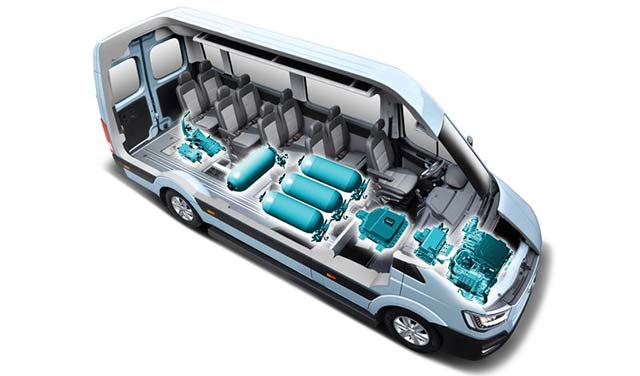Hyundai Motor has unveiled the zero-emissions H350 Fuel Cell Concept commercial van at the 2016 IAA Commercial Vehicle Show in Hanover.
The powertrain study shows the potential for the company’s advanced hydrogen fuel cell technology in the light commercial vehicle (LCV) segment.
Unlike a conventional electric vehicle, which requires a number of hours to recharge, the 175-litre hydrogen tank can be filled in under four minutes – similar to the time it takes to refill a tank of gasoline or diesel in a vehicle with a traditional internal combustion engine. The H350 Fuel Cell Concept has a total range of 422 km (262 miles).
The powertrain is intelligently packaged in such a way that its installation has no impact on the H350’s load area. Depending on wheelbase, the H350 provides 10.5 m3 or 12.9 m3 space – sufficient to accommodate five standard European pallets – or room for a 14-seat passenger compartment.
The Fuel Cell driveline enables almost silent operation of the vehicle contributing also to a reduction in noise pollution what makes it especially suitable for night deliveries in urban areas. The H350 Fuel Cell concept would be suitable not only for door to door and urban missions, but also to extended mileage missions thanks to the improved autonomy.
With the Fuel Cell powertrain capable of producing up to 100 kW (136 ps) and 30.6kg.m, the H350 Fuel Cell Concept is able to reach speeds of up to 150 km/h (93 miles) – similar performance to LCVs powered by an equivalent internal combustion engine. Propelled by a near-silent electric motor, it also produces significantly less noise than conventional vehicles.
The H350 Fuel Cell’s powertrain is formed of a hydrogen tank, fuel cell stack, high-voltage battery pack, inverter, and electric motor. The 700-bar high-pressure hydrogen tanks, located under the floor of the vehicle between the two axles, store 7.05 kg of compressed hydrogen, which is then broken down into protons and electrons in the fuel cell stack. The electricity produced by the fuel stack is then stored in a compact 24 kW lithium-polymer battery pack, with the inverter converting the energy to an alternating current to power the 100 kW electric motor.

